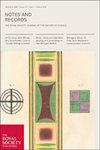Physical arguments and moral inducements: John Wallis on questions of antiquarianism and natural philosophy
IF 0.6
3区 哲学
Q3 HISTORY & PHILOSOPHY OF SCIENCE
Notes and Records-The Royal Society Journal of the History of Science
Pub Date : 2018-10-17
DOI:10.1098/rsnr.2018.0021
引用次数: 1
Abstract
In his posthumously published work Chartham News (1669), the antiquary William Somner tentatively sought to link the discovery of fossilized remains near Canterbury to the prehistoric existence of an isthmus connecting Britain and France, before calling on natural philosophers to pursue his explanation further. This call was eventually heeded by the Oxford mathematician John Wallis, but only after more than thirty years had elapsed. The arrival in England of a catalogue of questions concerning the geology of the Channel led to the republication of Chartham News in the Philosophical Transactions, prompting Wallis to develop a physical explanation based on his intimate knowledge of the Kent coastline. Unbeknown to Wallis at the time, that catalogue had been sent by G. W. Leibniz, who had in turn received it from G. D. Schmidt, the former Resident of Brunswick-Lüneburg in Sweden. Wallis's explanation, based on the principle of establishing physical causes both for the rupturing of the isthmus and for the origin of fossils, placed him in a camp opposed by Newtonian authors such as John Harris at a time when the priority dispute over the discovery of the calculus led to the severing of his ties with the German mathematician and philosopher Leibniz.物理论证和道德诱因:约翰·瓦利斯谈古物主义和自然哲学问题
在他死后出版的作品《查特姆新闻》(1669)中,考古学家威廉·索姆纳试图将坎特伯雷附近化石遗骸的发现与连接英国和法国的地峡的史前存在联系起来,然后呼吁自然哲学家进一步解释。这一呼吁最终得到了牛津数学家约翰·瓦利斯的重视,但仅仅在三十多年后。一系列关于英吉利海峡地质的问题抵达英国,导致《查特姆新闻》在《哲学汇刊》中重新出版,促使瓦利斯根据他对肯特海岸线的深入了解,提出了一种物理解释。沃利斯当时并不知道,这份目录是由G.W.莱布尼茨发送的,而莱布尼茨又是从瑞典前布伦瑞克-吕讷堡居民G.D.施密特那里收到的。瓦利斯的解释基于确定地峡破裂和化石起源的物理原因的原则,使他处于约翰·哈里斯等牛顿主义作家反对的阵营,当时关于微积分发现的优先权争议导致他与德国数学家和哲学家莱布尼茨的关系断开。
本文章由计算机程序翻译,如有差异,请以英文原文为准。
求助全文
约1分钟内获得全文
求助全文
来源期刊
CiteScore
1.50
自引率
0.00%
发文量
45
审稿时长
>12 weeks
期刊介绍:
Notes and Records is an international journal which publishes original research in the history of science, technology and medicine.
In addition to publishing peer-reviewed research articles in all areas of the history of science, technology and medicine, Notes and Records welcomes other forms of contribution including: research notes elucidating recent archival discoveries (in the collections of the Royal Society and elsewhere); news of research projects and online and other resources of interest to historians; essay reviews, on material relating primarily to the history of the Royal Society; and recollections or autobiographical accounts written by Fellows and others recording important moments in science from the recent past.

 求助内容:
求助内容: 应助结果提醒方式:
应助结果提醒方式:


